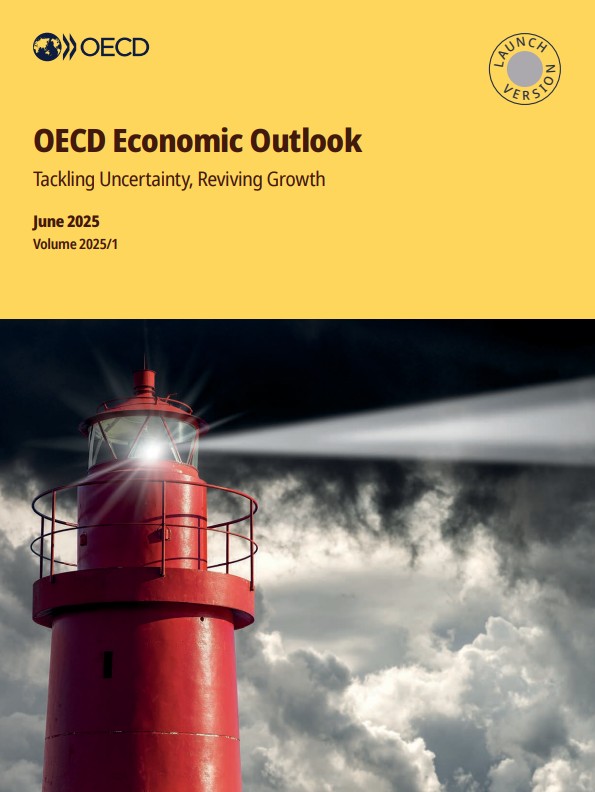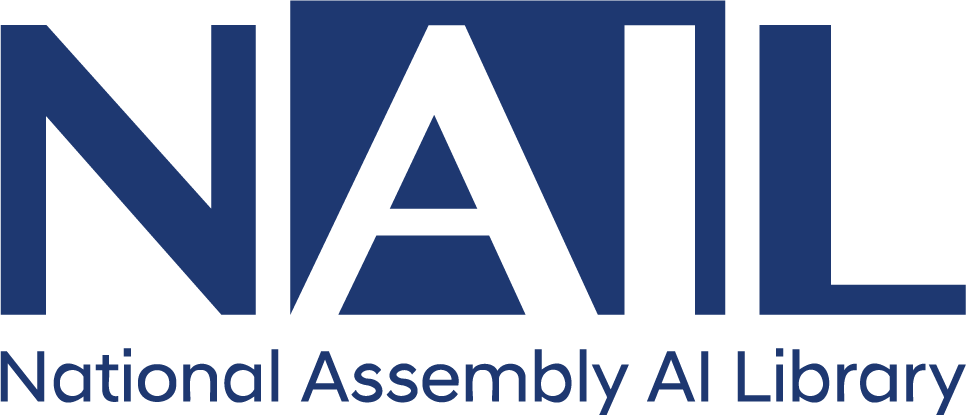
□ 경제협력개발기구는 세계경제가 더 어려워지고 있다(becoming increasingly challenging)고 진단하며 향후 세계경제 성장률은 '25년 2.9%('25.3월 전망 대비 △0.2%p), '26년 2.9%(△0.1%p)로 둔화(slow)될 것으로 전망함
ㅇ 무역장벽 확대, 금융 여건 악화, 기업·소비자 심리 약화, 정책 불확실성 확대 등이 지속될 경우 성장에 악영향을 미칠 수 있다고 언급함
ㅇ 성장 둔화는 미국·캐나다·멕시코등에 집중될 것이라고 언급함
ㅇ ▲미국은 실효 관세율상승, 무역 상대국의 보복조치 등으로 성장이 상당히 둔화(slow significantly)되며 '25년 1.6%, '26년 1.5% 성장이 전망됨. ▲일본은 소비·투자 증가가 대외수요 감소로 상쇄되며 '25년 0.7%, '26년 0.4% 성장이 전망됨. ▲유로존은 지속적인 자본지출, 회복력 있는 노동시장 등이 무역 갈등 영향을 상쇄하며, '25년 1.0%, '26년
1.2% 성장이 전망됨. ▲중국은 관세 인상 등 영향으로 성장이 둔화되나, 재정 부양책이 이를 일부 완화하며 '25년 4.7%, '26년 4.3% 성장이 전망됨
ㅇ 경제협력개발기구는 세계경제 성장의 하방요인으로 ①무역장벽 강화 또는 급격한 변화, ②기대인플레이션 상승에 따른 인플레이션 압력 장기화, ③위험자산
재조정(risk repricing) 과정에서 금융시장 불안 촉발 우려 등을 지적함. 상방요인으로는 무역장벽 완화(reversal of the increase in trade barriers) 등을 언급함
□ 한국경제의 경우, 관세 및 대외 불확실성이 수출·투자를 제약하는 한편, 민간소비는 정치적 불확실성 완화 및 실질임금 상승에 힘입어 '25년 후반 이후 회복을 예상함.
ㅇ 성장률은 '25년 1.0%('25.3월 전망 대비 △0.5%p)로 전년 대비 하락한 후, '26년은 2.2%('25.3월 전망과 동일)로 회복을 전망함.
ㅇ 물가상승률은 목표치에 근접한 수준인 '25년 2.1%('25.3월 전망 대비 +0.2%p), '26년 2.0%(△0.1%p)로 전망함
ㅇ 정책권고의 경우, 단기적으로 재정지원이 적절할 수 있으나, 지속가능한 장기 재정운용체계(framework) 마련이 병행되어야 한다고 조언함. 통화정책은내수 부진을 고려해 추가적인 완화(monetary policy loosening is warranted)를 권고함. 한편, 노동시장 개혁을 통해 성장을 촉진하고 노인 빈곤을 완화하며출산·육아(motherhood)에 따른 기회비용을 축소할 수 있다고 언급함
[출처] [보도참고] 경제협력개발기구, 6월 경제전망 발표 (2025.06.03.) / 기획재정부 보도자료
목차
Title page 1
Contents 4
Acknowledgements 8
Editorial: Tackling uncertainty, reviving growth 9
1. General assessment of the macroeconomic situation 11
Introduction 11
Recent Developments 13
Projections 27
Risks 33
Policies 43
References 60
Annex 1.A. Policy and other assumptions underlying the projections 64
2. Reigniting investment for more resilient growth 65
Summary 65
A prolonged period of weak investment has weighed on potential output growth 65
Business investment has been held back by subdued demand, elevated uncertainty and structural factors 68
Housing investment has fallen short of demand, reducing affordability 83
Public investment has picked up but remains below pre-GFC levels 84
Public policy reforms can help reinvigorate investment 85
References 95
Annex 2.A. An investment accelerator model 100
3. Developments in individual OECD and selected non-member economies 102
Argentina 103
Australia 106
Austria 109
Belgium 112
Brazil 115
Bulgaria 119
Canada 122
Chile 126
China 129
Colombia 133
Costa Rica 136
Croatia 139
Czechia 142
Denmark 145
Estonia 148
Euro area 151
Finland 155
France 158
Germany 162
Greece 166
Hungary 169
Iceland 172
India 175
Indonesia 179
Ireland 183
Israel 186
Italy 189
Japan 193
Korea 197
Latvia 200
Lithuania 203
Luxembourg 206
Malaysia 209
Mexico 212
Netherlands 215
New Zealand 218
Norway 221
Peru 224
Philippines 227
Poland 230
Portugal 233
Romania 236
Slovak Republic 239
Slovenia 242
South Africa 245
Spain 248
Sweden 251
Switzerland 254
Thailand 257
Türkiye 260
Ukraine 263
United Kingdom 266
United States 270
Viet Nam 274
Tables 7
Table 1.1. Global GDP growth is projected to slow 13
Figures 5
Figure 1.1. Global growth was holding up ahead of recent trade policy announcements 14
Figure 1.2. Recent trade policy announcements imply substantial change in effective tariffs 18
Figure 1.3. Direct exposure to US tariff increases 19
Figure 1.4. Direct and indirect trade effects 19
Figure 1.5. Recent economic indicators have weakened in several large economies 20
Figure 1.6. Near-term trade activity has been resilient 21
Figure 1.7. Financial conditions are tighter than at the end of 2024 22
Figure 1.8. Equity prices of companies sensitive to US tariffs have underperformed 23
Figure 1.9. Volatility has eased, but lower-rated corporate bond spreads remain elevated 24
Figure 1.10. Older workers have been an important source of increased labour supply 25
Figure 1.11. Inflation remains high with goods inflation having recently picked up 26
Figure 1.12. Inflation expectations have recently increased in some economies 27
Figure 1.13. Global growth is projected to weaken 28
Figure 1.14. The regional drivers of trade growth are changing 30
Figure 1.15. Current account balances will change only slowly 31
Figure 1.16. A more balanced labour market and stronger productivity growth should support disinflation 32
Figure 1.17. Inflation is projected to move further towards targets 32
Figure 1.18. Further trade cost increases and heightened uncertainty would harm growth 34
Figure 1.19. An increasing share of households in the United States and Canada are now expecting high inflation 35
Figure 1.20. Equity prices remain richly valued and many financial markets are increasingly concentrated 36
Figure 1.21. Expected corporate earnings continue to rise despite the widespread equity market decline in early April 37
Figure 1.22. Default risk premia have risen and bank performance has weakened 38
Figure 1.23. Global passive investing and use of derivatives by non-bank financial intermediaries have risen 40
Figure 1.24. Capital flows have been sensitive to exchange rate movements relative to the US dollar 41
Figure 1.25. Borrowing has become more challenging for lower income and riskier countries 42
Figure 1.26. Long-term real interest rates remain high but short-term real rates have declined 43
Figure 1.27. Policy rates are projected to decline further in most advanced economies 44
Figure 1.28. Real policy rates are projected to converge towards neutral levels 45
Figure 1.29. Public debt determinants in OECD countries 46
Figure 1.30. Substantial fiscal consolidation is projected in some high debt countries 47
Figure 1.31. Defence spending is increasing in advanced economies in Central and Eastern Europe 48
Figure 1.32. Ambitious military spending goals could force tough fiscal policy choices 50
Figure 1.33. Government spending patterns vary across OECD countries 52
Figure 1.34. Policy rates are projected to decline further in most emerging-market economies 53
Figure 1.35. Fiscal balances are expected to improve in most emerging-market economies 54
Figure 1.36. Opportunities exist to raise living standards by lowering trade barriers 55
Figure 1.37. Trade facilitation improvements lower trade costs 56
Figure 1.38. Improving services regulation would boost trade growth 57
Figure 1.39. Business investment gaps are large across OECD economies 58
Figure 1.40. The gap between financing costs and hurdle rates has increased 59
Figure 2.1. Weak capital accumulation has held back growth 66
Figure 2.2. Real investment remains below the pre-GFC and pre-pandemic trends in many economies 67
Figure 2.3. Net investment-to-GDP ratios have declined since the global financial crisis 68
Figure 2.4. Business investment has been weak across sectors 69
Figure 2.5. Business investment 'gaps' are large across OECD economies 70
Figure 2.6. The cost of capital has fallen and company valuations have held up 71
Figure 2.7. Strong corporate profitability has not translated into higher gross fixed capital investment 72
Figure 2.8. Uncertainty has increased, becoming a greater obstacle to investment 73
Figure 2.9. An uncertainty shock decreases business investment and GDP 74
Figure 2.10. Investment patterns have shifted towards the digital and knowledge-based economy 76
Figure 2.11. Tech firms lead the way in digital and knowledge investment growth 76
Figure 2.12. AI-related firms increasingly invest more than other firms 77
Figure 2.13. Declines in net business investment are driven by rising depreciation and weak non-digital tangible investment 78
Figure 2.14. Firms have used savings to accumulate financial assets and return funds to shareholders 79
Figure 2.15. The rate of return on corporate capital assets remains high 80
Figure 2.16. The gap between financing costs and hurdle rates has increased 80
Figure 2.17. Industry and product market concentration has increased 81
Figure 2.18. Markups have increased across OECD countries 82
Figure 2.19. Housing investment has not kept pace with demand, weakening affordability 84
Figure 2.20. Public investment was supportive in many countries during the aftermath of COVID-19 85
Figure 2.21. The major barriers to private investment can be influenced by government policy 86
Figure 2.22. Investment would benefit from further product market reforms 88
Figure 2.23. Restrictions on FDI are particularly pronounced in some emerging-market economies 90
Figure 2.24. Government involvement in venture capital deals varies greatly across countries 91
Figure 2.25. Government investment can have clear benefits for long-term growth 92
Figure 2.26. Effective corporate income tax rates vary strongly across assets and source of finance 94
Boxes 7
Box 1.1. The impact of US tariff policy changes will be significant 16
Box 1.2. The distribution of household inflation expectations 35
Box 1.3. Higher defence spending: economic and public finance implications 47
Box 2.1. Economic policy uncertainty and business investment in OECD countries 73
Box 2.2. Government investment and growth-enhancing structural outcomes 92
Box 2.3. Corporate income taxation and investment: impact and policy design considerations 94
Annex Tables 7
Annex Table 2.A.1. Panel regression results for simple accelerator model 100
Annex Table 2.A.2. Panel regression results for extended accelerator model 101



